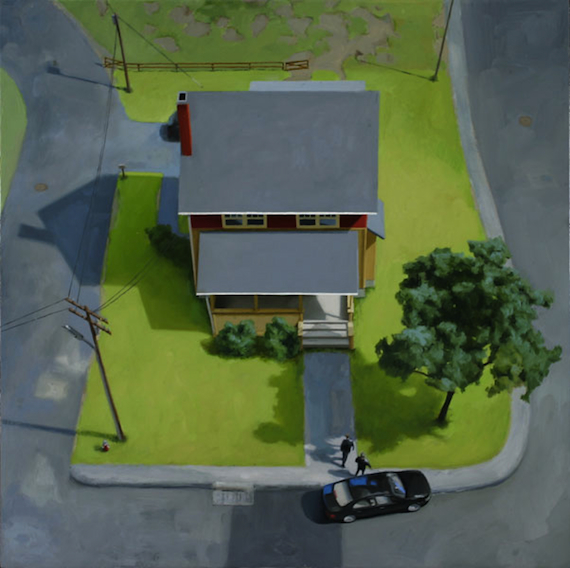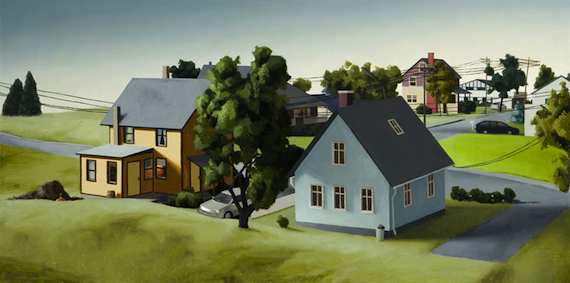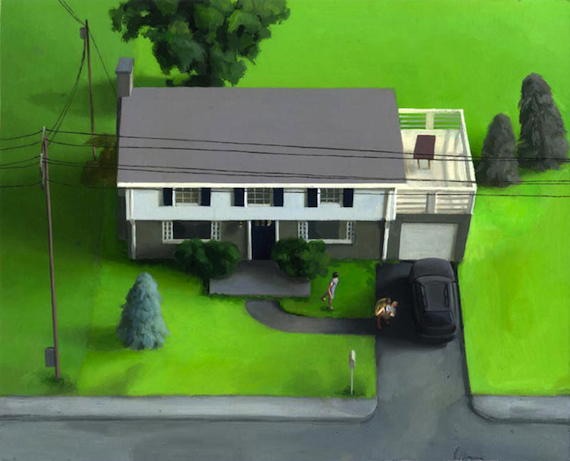1.
I wonder if it makes me stupid that when I am working on a book I often do not understand it very well until I see works by other artists who have embarked on similar projects. By other artists, here, I mean musicians, sometimes, or filmmakers, or sculptors, but usually I mean painters.
During the writing process — during the months and sometimes years it takes to compose a book — I keep my head down and try to shut out similar wavelengths that might serve to distract me. Then comes the moment when I can work no more, when the novel or collection of short stories or book-length essay is as done as it’ll ever be. At that point, I go looking for works of art that match it tonally. It’s not an organized search. It’s a random, rapid, catch-as-catch-can process. I listen to music with an acquisitive ear. I watch pieces of movies whose titles intrigue me. And, most of all, I scan through dozens of websites that collect images by contemporary artists. When I find a harmonizing work, I know it at once. There is recognition like looking in a mirror or into a face that is looking back at me. When that happens, I try to study those paintings so that I have a better sense of my own project. And then I try to solidify the relationship by using those works as my cover art.
This has been happening for years. For Superbad, my first book, I was pointed in the direction of Mark Tansey’s work, either by my publisher or a friend, and I ended up going to ask him for an image for the cover. Both that book and his work were about strange assemblages, irrational contrasts, and the deeper truths they revealed. I picked a painting that imagined Picasso and Braque as the Wright brothers, getting Cubism off the ground at Kitty Hawk.
A few years ago, for a collection of short stories about loneliness and letter-writing, I ended up using a painting by Alyssa Monks, who now primarily prints photorealistic self-portraits of herself in the shower. The work I picked was an earlier painting of a woman in a hotel room, looking away from the viewer, looking forlorn. Using it as a book cover halved the image, or at least relegated the left section of it to the back cover — it showed a man reaching into the inside pocket of his suit coat. The whole thing was intimate and eerie and more than a little sad, a portrait of debauchery with consequences.
When that book came out, I invited Alyssa to my launch party, and talked to her a bit about the differences and similarities between our works: not just thematically, but compositionally and philosophically. What are the limits of a painting, and how are they similar to or different than the limits of a short story? Why does a shadow, which is almost always symbolic in a work of fiction, sometimes just function visually in a painting? Significance is placed and displaced differently. A kind of empty space that works against the writer may in fact aid the painter. We agreed that similar projects could come to vastly different ends.
2.
My new novel, The Slippage, struck me as strange, even as I was writing it. It’s a story about the suburbs, where I grew up, and about marriage, where I grew up again. As I wrote the book, I noticed the absence of several of the pleasures that I had become accustomed to seeing in my work. There wasn’t much humor, or much kinetic energy. There weren’t upjuts of surprise. It was, from start to stop, an altogether quieter affair whose argument was made subtly and whose outlook was bleak in a way that people might consider tiring. I wanted to put a stake in or at least near the heart of the culture that had made everyone dependent upon communication and attention; along the way, I had some close readers I had to retrain, including myself.
When I went looking for visual matches, I thought it would be easy. One of my characters was a chart artist. He was originally the main character, but as the book developed, he slid out toward the edge of the narrative. He made charts and graphs that were themselves about the way that charts and graphs failed to accurately represent experience or even data. The book originally included these charts as chapter openers, but they were squeezed out as that character became more marginal and the book became more centrally about marriage. It occurred to me that I find works that were similar to the charts: works that burlesqued the idea of objectivity and rational processing of experience. I looked at dozens of artists who seemed to be doing exactly that, though, and there was more disjunction than harmony. Another week went by, and then another. The book was done and I hadn’t found anything that seemed to share the same tone.
And then I came upon the paintings of Amy Bennett. Bennett paints scenes of oddly quiet suburban neighborhoods. They are spacious and spooky. People figure in them notionally. Here are some.



I liked her images at once, and I liked them more the longer I looked at them. They were narrative, certainly, though their plots and character studies operated primarily by implication. They had a limited palette, which rewarded close study and made the minor variations from it more noteworthy. They seemed, somehow, to have a downward pull, to drain out of the bottom of the canvas; I liked this for its pessimism and its clarity. I bundled up a bunch of images and sent them along to my publisher.
A few months later, the publisher sent back a set of covers for me to consider. The four that I liked best used Bennett’s paintings. I took credit for forwarding them, but as it turned out, no one was certain that my initial suggestion was what had led the publisher to the work. An art director may have found them independently. That only confirmed my initial suspicion that her paintings were a kind of mirror of my book, that they addressed the same concerns, with some of the same methods.
I wrote Amy, who I did not know, and thanked her for allowing her painting to be used as my book cover. That was standard procedure and as a result she was happy to hear from me. Then I asked her if she would be willing to discuss the strange process by which works in different media become spiritually congruent. That seemed more taxing to her because it was. She was happy to talk, she said, but she was in the middle of a project and as a result couldn’t promise that she could focus on it to any great degree. As it turned it, she could. We corresponded back and forth and the invisible lines that connected her paintings to my book rose into view.
I grew up in the suburbs and assumed that she had, too, or at the very least that she had lived there for much of her life. In fact, she grew up in Maine, in a rural area near a small town. People there, she said, kept to themselves. Then she moved to Brooklyn, to a large apartment building, where people were close to one another but where they also kept to themselves. “I really enjoyed the anonymity of the city,” she wrote. As I said, when I contacted her, she said that she was in the middle of a project. The project, as it turned out, was specifically related to place and identity. She was in the process of moving out of the city, to a town upstate. “This,” she wrote, “will be my first real suburban experience.”
That was a surprise to me, that she had never really lived in the suburbs. It made me think that her paintings were about an unreal place — or rather, a place that cross-bred the two places she had lived into a third imagined but real place. Even more surprising were her ideas about what the relocation might involve: “I’m looking forward to having a little more space and small yard and even bought a car for the first time, but I have mixed feelings about moving into such a small, close-knit community.” This anticipation of her move also anticipated some of the themes of the novel. The unnamed town in “The Slippage” is relatively small and relatively close-knit, though there is not any strong sense that this creates real knowledge about others or about the self.
I was most interested by her thematic take on her own artwork. Ask an artist about the things they make, and you’ll get the strangest answers. They are the closest to that work and sometimes, as a result, the furthest from it as well. They are not objective observers and so they do not always have reason, but they have hope and that is reason enough to ask them. When I grew up in the suburbs in the seventies, life seemed largely meaningless, a succession of artificial tasks subjected to artificial approval or disapproval, and it was exactly that meaninglessness that compelled me to start reading and then, a little later, to start writing. Her paintings, to me, were about this same problem: facades and the secret hope that they concealed something more meaningful. I asked her that, in a way: “Does meaningless produce meaning?” Her reply was cautious: “That’s quite a question, and maybe one that my paintings ask in some way, but I’m not sure that I have an answer apart from I hope so. Somehow I find meaning in work and filling my role in the cycle of life. As an agnostic with a whole lot of doubt I find it hard to keep my chin up if all of this meaninglessness doesn’t amount to anything.” There it was again, more than once: hope.
There was a second issue, which was one of preparation and control. Whenever I created fictional characters, I liked to set them in detailed worlds: not real worlds, necessarily, but worlds that could in theory be real. That’s why I had created a hundred charts for my fictional chart artist, and why, for a novel about a funk-rock star a few years earlier, I had written two albums’ worth of lyrics. Amy, her website explained, painted from models: she built the tiny houses before she painted their portrait. I wondered why she did this, why she gave additional reality to scenes that were, in the end, oddly unreal. “Building models for my paintings serves a few purposes at once,” she wrote. “The most obvious is the model becomes a still life for me to observe natural light hitting an actual object, even though it’s depicting a scene from my imagination. I paint differently when I work straight from my imagination versus from observation. It lends an air of credibility to a phony scene. Perhaps more importantly, making a model forces me to fully realize something that might otherwise be a little fuzzy in my mind or memory.”
This made good sense. Modeling things — whether theories or plots or imaginary houses — forces us to make the parts fit together, or to foreground the fact that they do not. But there was another dimension to her model-making that hit even closer to home. Amy, as it turned out, recycled the pieces of her houses. “I pull apart the model and reuse bits for future models,” she wrote. “So the biggest difference between the models and the paintings, is that the models are kind of junky looking, whereas (hopefully) the paintings are not. The models are made of cheap materials that I use over and over again — cardboard, glue, wire, foam, plastic, etc. and they look like a toy. I hope the paintings transcend a faithful rendering of a toy and become an alternate, fictional world.” I had, three days earlier, done an email interview with a woman who asked whether I ever reuse parts of my books for other books. “All the time,” I said. “In fact, the new book is just an old book with the words in different order.” I was joking, but only to conceal a truth. My books have been, on their faces, very different from one another. I have written experimental short fiction, traditional short stories, a funk-rock novel, a humor book that used Chekhov’s stories as its basis. But in my mind, they have all been the same book, rearranged and recycled. This new one, even though it’s superficially quite different from any that has come before, has some of the same guts as the others. And I don’t just mean that they address the same themes of creative paternity and disconnection from the broader world. I mean that there are recycled parts: I reuse characters and places sometimes, or even snippets of dialogue or entire sentences. I am suspicious of authors who create fictional world that aren’t, in some way, connected to their other fictional worlds. We make neighborhoods that we then inhabit. If you write something that you think is unprecedented, look through your old work. You’ll find a piece of it. Amy’s method — building a model and then using it as a chop-shop for future models — seemed like an excellent metaphor. And what was the result? “I want the scenes to look possible, but for unsettling clues like shifts of scale to signal to the viewer that these images are just playing at reality,” she wrote. “I think the paintings are most interesting when they are straddling fake and realistic worlds.” In my book, I created a street grid for my fake suburb, and then violated it whenever possible — streets that are identified as parallel early in the book turn out to be perpendicular later. None of the violations are consequential for the plot, but they begin, over time, to create a slight sense of unreality. Her answers were getting closer and closer to the things I liked to tell myself about my own work.
Many of Amy’s paintings made sense to me as extensions of my novel—or maybe it was my novel that was an extension of her paintings — but one struck me as particularly appropriate. It was a vertical painting in which a house, seen from overhead, seemed stuck precariously to its foundation, as if it might slip away at any moment. This worked as a pun, and also as a thematic echo. She identified the perspective as literary and even a bit self-deceiving: “The bird’s eye view is one I keep coming back to. In fact, I think my next series will be mostly done from that perspective. To me it’s like an omniscient narrator. It gives all of the information with a somewhat detached coolness, as if it is undisputed fact.” A little later on, she made another observation about her own work that also seemed to directly address mine: “Often it is the relationship between characters, rather than individual characters, that I am interested in depicting.” I had just finished making this case to a friend of mine who had read my book and had a quarrel with the way I had portrayed one of the main characters. He kept talking about her in isolation, as if she had a true personality that the book was withholding, and I kept explaining back to him that she only existed within her interactions with others. I started to forward Amy’s message to him, with that sentence highlighted, but I stopped before I sent it. It didn’t seem right to have her fight my battles for me. I should be able to explain my work without borrowing someone else’s insights into their work. And yet, here we are, two thousand words into the opposite.
3.
So what does it mean for a novel and a painting to share the same interests? They exist in different kinds of spaces. They are perceived (and possessed) differently by audiences. They are forced to jump through different kinds of hoops to attain critical notice. Can they truly be fraternal twins? I had been building a case, but I started to doubt my own motives. Maybe I was trying to anchor my work in another artist’s work to keep it from disappearing — from slipping away. And yet, in the end, my time with Amy’s work, which followed close upon the heels of my time with my own, had done exactly what I hoped for: it had returned me to some of the basic questions that I had set out to explore, and then shown me that it was not possible to spend too much time inside the inquiry without bumping into another explorer. It’s not fellowship, exactly, but a strong sense of being alone together, which seems like a good way of describing the creative impulse.
The painting of Amy’s that I picked for my cover is called “Salute to Water Bodies.” It opens this piece, though it is defaced by my name and the novel’s title. In honor of the painting, and of the work it has done – within me, and I assume, within other viewers — I will end by showing it again, this time without my nonsense on it.





